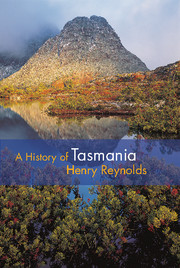Book contents
- Frontmatter
- Contents
- Illustrations
- Acknowledgements
- Introduction
- 1 First Meetings, Extraordinary Encounters
- 2 Van Diemen's Land: Settling in the enviable island
- 3 The Black War: The tragic fate of the Tasmanian Aborigines
- 4 An Indelible Stain?
- 5 The Triumph of Colonisation
- 6 The Politics of Van Diemen's Land
- 7 The Convict System
- 8 Post-penal Depression, 1856–70
- 9 Reform and Recovery
- 10 Federation and War
- 11 Between the Wars
- 12 Postwar Tasmania
- 13 Towards the Bicentenary
- Notes
- Sources
- Index
13 - Towards the Bicentenary
Published online by Cambridge University Press: 05 April 2012
- Frontmatter
- Contents
- Illustrations
- Acknowledgements
- Introduction
- 1 First Meetings, Extraordinary Encounters
- 2 Van Diemen's Land: Settling in the enviable island
- 3 The Black War: The tragic fate of the Tasmanian Aborigines
- 4 An Indelible Stain?
- 5 The Triumph of Colonisation
- 6 The Politics of Van Diemen's Land
- 7 The Convict System
- 8 Post-penal Depression, 1856–70
- 9 Reform and Recovery
- 10 Federation and War
- 11 Between the Wars
- 12 Postwar Tasmania
- 13 Towards the Bicentenary
- Notes
- Sources
- Index
Summary
The 1969 election was a political watershed. On one side was the long period of Labor rule. On the other was a quite different era with more rapid change of government and the emergence of a mass environmental movement and ultimately the creation of the Greens Party, which, by the bicentenary year, had become a permanent feature of Tasmanian political life. Other things remained the same. The Hare-Clark system continued to distinguish Tasmanian elections and characteristically produced governments with tiny majorities. Further reform took away the power of party organisations to present lists of candidates, which ensured success for those most favoured by the party. Ballot papers were printed with a random selection of candidates so that everyone appeared at the top of the ballot paper an equal number of times. The parties could no longer hand out how to vote cards with their pre-arranged hierarchy of candidates. The innovation pitted electoral aspirants against their party colleagues as well as their political opponents. It was a welcome reform because it transferred power from the parties to the people who often used it with fine judgement to reward the conscientious local member and punish those who had taken the electorate for granted. The Legislative Council continued to trouble governments and despite endless talk of reform it remained, as it had been since 1856, one of the most powerful upper houses in the democratic world. The members eventually accepted the inevitability of universal suffrage and so shed the image of being a bastion of wealth and privilege. Electors in the periodic council elections continued to vote for independents, although the Labor Party made many attempts to capture an ever-elusive majority.
- Type
- Chapter
- Information
- A History of Tasmania , pp. 274 - 293Publisher: Cambridge University PressPrint publication year: 2011



